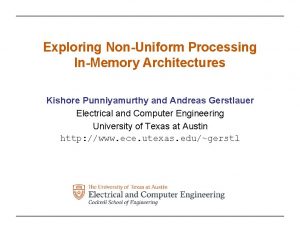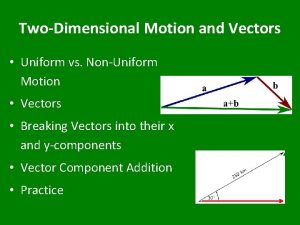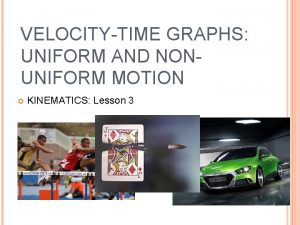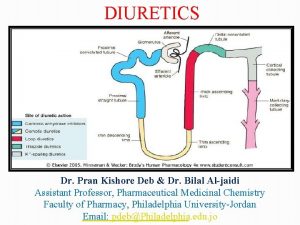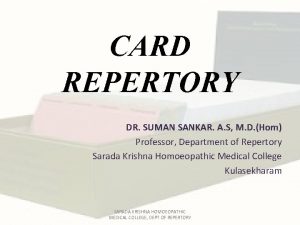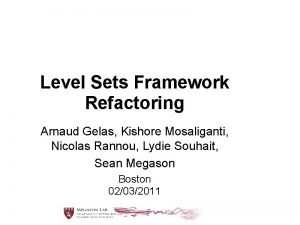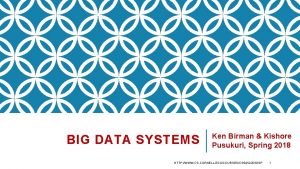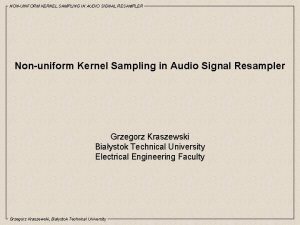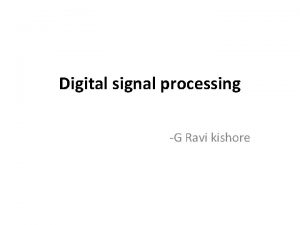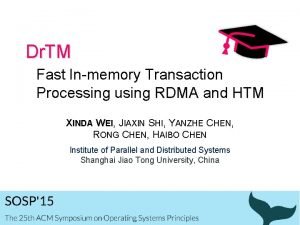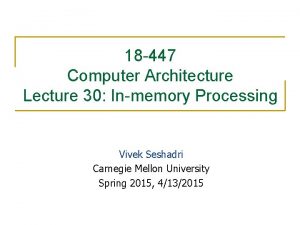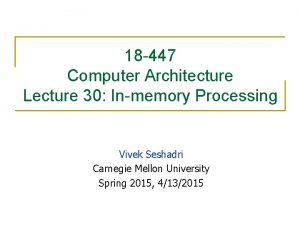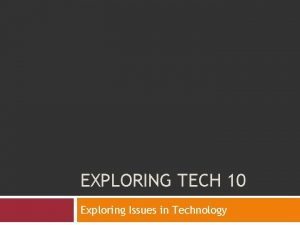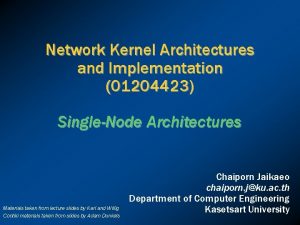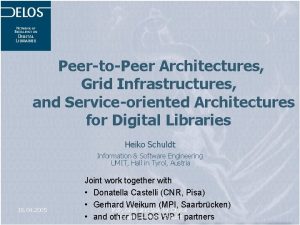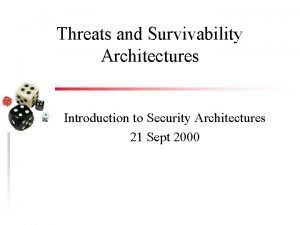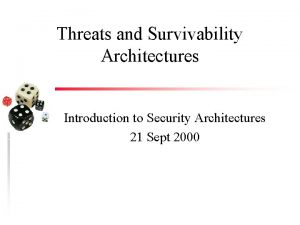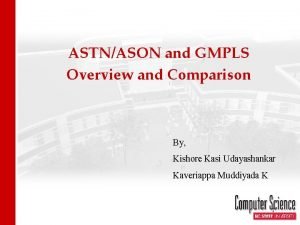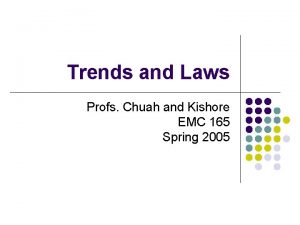Exploring NonUniform Processing InMemory Architectures Kishore Punniyamurthy and





















- Slides: 21

Exploring Non-Uniform Processing In-Memory Architectures Kishore Punniyamurthy and Andreas Gerstlauer Electrical and Computer Engineering University of Texas at Austin http: //www. ece. utexas. edu/~gerstl

Traditional PIM • Central compute + external memory stacks • Small compute into external logic layers • Offload memory intensive part of application • Limited by small in-memory compute }-- DRAM Layers Logic Layer with compute Off-chip links GPU clusters 5/22/2021 CPU cores GPU clusters © K. Punniyamurthy et al. 2

Technology Trends • In-package high bandwidth memory now feasible • Needed in exascale system for bandwidth [Vijayraghavan’ 17] Ø Move memory into central package GPU clusters 5/22/2021 CPU cores GPU clusters © K. Punniyamurthy et al. 3

Centralized Compute & Memory • Large central compute can exploit in-package bandwidth • Offloading of application section not required • Still need external memory for capacity Ø Integrate more compute into external memory stacks Logic Layer GPU clusters Interposer CPU cores 5/22/2021 © K. Punniyamurthy et al. 4

Non-Uniform Multi-Element • Multiple elements with different memory to compute ratio • Application that can be partition with high memory footprint Ø Further distribute compute CPU cores 5/22/2021 © K. Punniyamurthy et al. 5

Uniform Multi-Element • Multiple elements with same memory to compute ratio • Extreme case is completely homogeneous • Different non-uniform PIM architectures possible • Each with different benefits and cost • Highly application dependent Ø Need to determine suitability of different architectures CPU cores 5/22/2021 © K. Punniyamurthy et al. 6

Outline ü Background ü Non-uniform PIM (NUPIM) architecture space • Application Analysis • Low sharing • High sharing • Experiments & Results • Architectures evaluated • Performance results & analysis • Summary, Conclusions and Future work 5/22/2021 © K. Punniyamurthy et al. 7

Application Analysis • Understanding inter-thread sharing behavior vital • Classify applications according to sharing behavior • Low sharing • High sharing • Based on pre-dominant behavior • Benchmarks in reality fall between classes 5/22/2021 © K. Punniyamurthy et al. 8

Low Sharing • Regular behavior • Memory footprint scales with threadblocks • Distributed without increasing off-chip accesses • Potentially favors uniform memory to compute ratio Ø Nearest Neighbor (NN) [Rodinia] 5/22/2021 © K. Punniyamurthy et al. 9

High Sharing • Irregular behavior • Data dependent accesses • Distributing threadblocks increases off-chip accesses • Potentially favor large centralized compute Ø BFS [Rodinia] 5/22/2021 © K. Punniyamurthy et al. 10

Experimental Setup • GPGPUSim v 3. 2. 2 • Modified to replicate different architecture configurations • Data Mapping • Locality based for low page sharing applications [Diener’ 13] • Interleaved data mapping for high page sharing [Mariano’ 16] • Benchmarks Benchmark Page sharing Input Suite NN Low 5120 k Rodinia BFS High Graph 1 MW Rodinia Lulesh High Default (first 26 kernels) Lulesh SPMV High Large (first 5 kernels) Parboil Btree High Default (1 M) Rodinia 5/22/2021 © K. Punniyamurthy et al. 11

Architectures Evaluated (1) • Centralized compute • SMs only in central element • In-package and external memory stacks • No external compute SM Cluster 0 SM Cluster 1 SM Cluster 7 Memory Interconnect Memory Memory --- Memory Central package 5/22/2021 © K. Punniyamurthy et al. 12

Architectures Evaluated (2) • Non-uniform multi-element • Big. Little 2 SM Cluster 0 SM Cluster 1 SM Cluster 8 --- Interconnect Memory SM Cluster 0 SM Cluster 7 Memory Memory Central package • Big. Little 4 SM Cluster 2 SM Cluster 0 SM Cluster 1 Interconnect Memory SM Cluster 3 SM Cluster 9 SM Cluster 10 --Interconnect Memory SM Cluster 11 Interconnect Memory Central package 5/22/2021 © K. Punniyamurthy et al. 13

Architectures Evaluated (3) • Uniform multi-element • Identical memory stacks with compute • Uniform memory to compute ratio SM Cluster 0 Interconnect Memory 5/22/2021 SM Cluster 1 Interconnect SM Cluster 7 --- Memory © K. Punniyamurthy et al. Interconnect Memory 14

Results: Speedup • NN performs 78% better in uniform multi-element architecture • High page sharing applications perform better in Big. Little 2 (avg. 6%) and Big. Little 4 (avg. 13%) than centralized compute 5/22/2021 © K. Punniyamurthy et al. 15

Results: Off-Chip Hops • NN has lower off-chip hops in uniform multi-element architecture • Big. Little 2 and Big. Little 4 have higher off-chip hops, 7% and 20% respectively for high page sharing applications 5/22/2021 © K. Punniyamurthy et al. 16

Results: Interconnect Congestion • NN has lower interconnect congestion in uniform multielement architecture • Big. Little 2 and Big. Little 4 have 9% and 17% less stalls due to interconnect congestion 5/22/2021 © K. Punniyamurthy et al. 17

Deepdive: Lulesh • Calc. Pressure. For. Elems and Update. Volume. For. Elems kernels perform equally good in centralized compute and Big. Little 4 • Big. Little 2 performs as good as Big. Little 4 for Calc. Lagrange. Elem. Part 2 and Apply. Acceleration. Boundary. Condition kernels 5/22/2021 © K. Punniyamurthy et al. 18

Deepdive: Lulesh • Integrate. Stress. For. Elem • Dominant kernel • Irregular memory accesses • Results in higher contention • Favors Big. Little 4 • Different kernels have different behaviors • No optimal single configuration • Calc. Lagrange. Elem. Part 2 Ø Potential for kernel-level dynamic mapping • Regular memory accesses • Less contention • Favors Big. Little 2 under interleaved mapping 5/22/2021 © K. Punniyamurthy et al. 19

Summary, Conclusions and Future Work • No global optimal architecture • Low sharing: uniform multi-element • High sharing: non-uniform multi-element Ø Dynamic mapping on NUPIM baseline architecture • Less remote accesses not always better • Other factors (e. g. contention) can offset adverse impact • Future work • More benchmarks and applications • Power considerations • Architecture configurations • Dynamic mapping schemes 5/22/2021 © K. Punniyamurthy et al. 20

Thank You! Questions? 5/22/2021 © K. Punniyamurthy et al. 21
 Kishore punniyamurthy
Kishore punniyamurthy Motion uniform and nonuniform
Motion uniform and nonuniform Graphical representation of uniform and nonuniform motion
Graphical representation of uniform and nonuniform motion Database and storage architectures
Database and storage architectures Autoencoders
Autoencoders Sar of loop diuretics
Sar of loop diuretics Boger synoptic key ppt
Boger synoptic key ppt Jeevan kishore plan 102 benefits
Jeevan kishore plan 102 benefits Kishore mosaliganti
Kishore mosaliganti Kishore pusukuri
Kishore pusukuri Integral product architecture
Integral product architecture Base system architectures
Base system architectures Backbone network components
Backbone network components Scalable internet architectures
Scalable internet architectures Product architecture example
Product architecture example Gui architectures
Gui architectures Database system architectures
Database system architectures Cdn architectures
Cdn architectures Aaron bannert
Aaron bannert Three tier architecture of data warehouse
Three tier architecture of data warehouse Instruction set architecture examples
Instruction set architecture examples Client server
Client server
